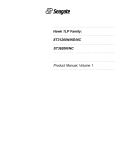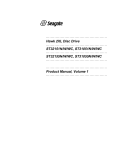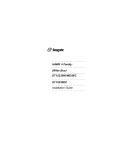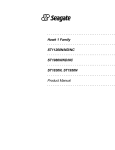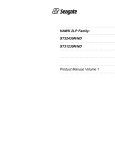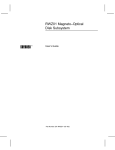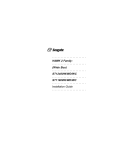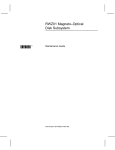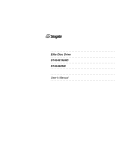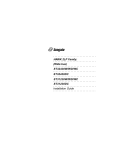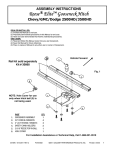Download Seagate Elite 9 User`s manual
Transcript
............................. Elite Disc Drive ............................. ST43400N/ND ............................. ............................. User’s Manual ............................. ii Contents Preface .................................................................................................... Electrostatic discharge protection ........................................................ Important safety information and precautions ...................................... Technical support services .................................................................. Section 1. General description ................................................................ Section 2. Installation .............................................................................. Section 3. Operation ............................................................................... Section 4. Parts data ............................................................................... Section 5. Maintenance ........................................................................... iii iii iv vi 1 7 33 37 39 © 1992 Seagate Technology, Inc. All rights reserved Publication Number: 83327630, Rev. A Seagate® , Seagate Technology® , and the Seagate logo are registered trademarks of Seagate Technology, Inc. EliteTM, SeaFAXTM, SeaFONETM, and SeaBOARDTM are trademarks of Seagate Technology, Inc. Other product names are registered trademarks or trademarks of their owners. No part of this publication may be reproduced in any form without written permission from Seagate Technology, Inc. ST43400N/ND User’s Manual iii Preface This manual contains information for users of the Seagate ST43400N and ST43400ND Elite disc drives employing the SCSI interface. It provides installation, operation, and maintenance information. This manual also lists the part numbers for options and accessories available for these drives. Additional information is available in the reference manual (publication 83327640). Electrostatic discharge protection Caution. Removal of circuit boards by personnel not performing depot repair will damage components and may void the warranty. All drive electronic assemblies are sensitive to static electricity, due to the electrostatically sensitive devices used within the drive circuitry. Although some devices such as metal-oxide semiconductors are extremely sensitive, all semiconductors, as well as some resistors and capacitors, may be damaged or degraded by exposure to static electricity. Electrostatic damage to electronic devices may be caused by the direct discharge of a charged conductor or by exposure to the static fields surrounding charged objects. To avoid damaging drive electronic assemblies, observe the following precautions when installing or servicing the drive: • Ground yourself to the drive whenever the drive electronics are or will be exposed. Connect yourself to ground with a wrist strap (refer to accessories in Section 4 for part numbers). Connection may be made to any grounded metal assembly. As a general rule, remember that you and the drive electronics must all be grounded to avoid potentially damaging static discharges. • Turn off the power before removing or installing the DC power cable. • Do not remove any circuit boards from the drive. • Never use an ohmmeter on any circuit boards. iv Important safety information and precautions Caution. Use forced-air ventilation when bench-testing the drive to ensure proper cooling of drive components. Use proper safety and repair techniques for safe, reliable operation of this unit. Service should be done only by qualified persons. We recommend the procedures in this manual as effective ways of servicing the unit. Some procedures require the use of special tools. For proper maintenance and safety, you must use these tools as recommended. The procedures in this manual and labels on the unit contain warnings and cautions that must be carefully read and followed to minimize or eliminate the risk of personal injury. The warnings point out conditions or practices that may endanger you or others. The cautions point out conditions or practices that may damage the unit, possibly making it unsafe for use. You must also understand that these warnings and cautions are not exhaustive. We cannot possibly know, evaluate, and advise you of all the ways in which maintenance might be performed or the possible risk of each technique. Consequently, we have not completed any such broad evaluation. If you use a non-approved procedure or tool, first ensure that the method you choose will not risk either your safety or unit performance. Always observe the following warnings and precautions: • • • • Perform all maintenance by following the procedures in this manual. Follow all cautions and warnings in the procedures. Use sound safety practices when operating or repairing the unit. Use caution when troubleshooting a unit that has voltages present. Turn off power to the unit before servicing it. • Wear safety shoes when removing or replacing heavy parts. • Provide a means to isolate the drive from the main power in case of fire or other emergency. • Ensure that the internal temperature of the rack or cabinet does not exceed the limits defined for the drive, when the drive is mounted in an equipment rack or cabinet. When units are stacked vertically, pay special attention to the top where temperatures are usually highest. • Follow the precautions listed above in “Electrostatic discharge protection.” • Do not remove any circuit boards from the drive chassis. Return the entire drive for depot repair if any circuit board is defective. Removal of circuit boards by personnel not performing depot repair will damage components and may void the warranty. ST43400N/ND User’s Manual v • Do not remove the head and disc assembly (HDA) from the drive chassis. Return the entire drive for depot repair if the HDA is defective. • Do not attempt to disassemble the HDA. It is not field repairable. If the sealed HDA is opened by personnel not performing depot repair, this will damage components and void the warranty. As a component, this drive is designed to be installed and operated in accordance with UL1950, IEC950, EN60950, CSA C22.2 950, and VDE0806. Refer to section 2 for information about installation. If you do not use a Seagate power supply, ensure that the supply meets the specifications in this manual and is designed to be used in accordance with UL1950, IEC950, EN60950, CSA C22.2 950, and VDE0806. Seagate takes all reasonable steps to ensure that its products are certifiable to currently accepted standards. Typical applications of these disc drives include customer packing and subsystem design. Safety agencies conditionally certify component parts, such as the Elite disc drive, based on their final acceptability in the end-use product. The subsystem designers are responsible for meeting these conditions of acceptability in obtaining safety/regulatory agency compliance in their end-use products and for certifying where required by law. A necessary part of meeting safety requirements is the provision for overcurrent protection on drive SELV supply voltages. This unit is a component assembly and as such is not meant to comply with FCC or similar national requirements as a stand-alone unit. Engineering radiated and conducted emissions test results are available through the Seagate Safety Department to assist the subsystem designer. vi Technical support services Seagate Technology provides technical support literature and diagnostic utilities to authorized distributors. Please contact your dealer for technical support and installation troubleshooting. Product technical support is available for all Seagate products by calling the SeaFAX, SeaFONE, or SeaBOARD services. These are toll calls if you dial from outside of the number’s local dialing area. SeaFAX: (408) 438-2620 You can use a Touch-Tone telephone to access Seagate’s automated FAX delivery system and select technical support information by return FAX. This service is available twenty-four hours a day, seven days a week. SeaFONE: (408) 438-8222 The enhanced phone system provides recorded technical information on selected Seagate products while you are on hold. Technical support specialists are available to answer questions from 8:00 A.M. to 5:00 P.M. PST, Monday through Friday. Recordings are accessible twenty-four hours a day, seven days a week. SeaBOARD: The Seagate Technical Support Bulletin Board System (BBS) is available twenty-four hours a day, seven days a week. A modem is required to access this service. The communications software must be set for eight data bits no parity and one stop bit (8N1). With this service you can access: • Specifications and jumper configurations for all Seagate products • Reprints of Seagate documentation • A directory of information and helpful utilities that you can download to your own computer Location Telephone Number Maximum Baud Rate United States/Canada (408) 438-8771 9600 England 44-62-847-8011 9600 Germany 49-89-140-9331 2400 Singapore 65-227-2217 9600 Australia 61-2-756-2359 9600 Note. This is a toll call if you dial from outside of the number’s local dialing area. 1 Section 1. General description The Seagate ST43400N/ND Elite 3 disc drives are high speed, random access digital data storage devices. They communicate with an initiator using the Small Computer System Interface (SCSI). The drive is shown in Figure 1, and its specifications are listed in Table 1 on the following page. The drive is a component for installation in an enclosure designed for the drive. The enclosure design must ensure adequate cooling for the drive, and it must address the requirements for grounding and for shielding of emissions. The reference manual (publication 83327640) presents guidelines for designing the enclosure, but the design is your responsibility. Control Board Power Board Optional Bezel Spindle Sync Connector Option Jumpers Option Jumpers Option Jumpers Pin 1 I/O Connector Chassis Head and Disc Assembly (HDA) DC Power Connector Figure 1. The ST43400N/ND disc drive 2 Table 1. Drive specifications Characteristics Conditions Specifications Size Dimensions See “Space requirements” in section 2 Weight (drive only) 3.6 kg (8.0 lb) Weight (power supply only) 2.3 kg (5.0 lb) Interface Fast SCSI-2 Recording Total capacity (unformatted) 3,554,871,600 bytes Bytes per track (unformatted) Inner track Outer track 49,000 bytes 72,800 bytes Formatted capacity* (256-byte sectors) (512-byte sectors) (1,024-byte sectors) 2,538,290,688 bytes 2,916,687,360 bytes 3,150,686,208 bytes Number of discs 11 Recording heads 21 Servo heads 1 Physical heads per surface 1 Cylinders per head/disc assy 2,738 (includes 2 spares) Cylinders available to user 2,736 Spare cylinders 1 System cylinders 1 Diagnostic cylinders 1 Spare sectors per cylinder 6 Modulation 1,7 code * Excluding spare sectors, spare cylinders, diagnostic cylinders, and system cylinders. continued General description 3 continued from previous page Characteristics Conditions SCSI transfer rate, burst Specifications 10.0 Mbytes/sec max Seek time (time required to move heads to a different track address— excluding SCSI I/O overhead) Typical full 23.5 msec Typical average 11.5 msec Typical one-track 1.7 msec Typical access times Write Read Typical single track seek msec 1.7 0.9 Average seek msec 11.5 10.5 Maximum seek msec 23.5 22.5 Average 5.55 msec (disc rotation at 5400 RPM) Maximum 11.17 msec (disc rotation at 5373 RPM) Latency (time required to reach a particular track address after head positioning is complete) Start time** 30 sec max Stop time 30 sec max ** Following the power sequence delay, once DC power is applied and start conditions are present. 4 The drive contains all the circuits and mechanical devices necessary to record data on and recover it from its discs. The drive requires DC voltage input from an external power supply, which receives its AC input power from the site main power source. A power supply and DC power cable are available accessories. The drive consists of a head and disc assembly (HDA) and two circuit boards, mounted on a common chassis. The circuit boards contain the electronics required for drive operation. The HDA is a sealed unit containing the electromechanical components used for data retrieval and storage. These components include the discs, spindle, drive motor, actuator, heads, and preamplifiers. The 11 discs provide the recording medium for the drive. These discs are mounted on a spindle, and the spindle is coupled directly to the drive motor. The drive motor rotates the discs at 5400 RPM and produces a circulation of air within the sealed HDA. The built-in SCSI controller directs all drive functions, receives commands from the initiator (host computer), interprets them, and then transfers the necessary commands to the drive. The controller therefore allows the initiator to start an operation and then disconnect to service another device. Refer to the reference manual for a description of interface functions. All drive operations are related to data recovery and storage (normally referred to as reading and writing). The actual reading and writing is performed by heads that are positioned over the rotating discs’ recording surfaces. There is one head for each data surface. The heads are positioned in such a way that data is written in concentric tracks around the disc surfaces (see Figure 2). Before any read or write operation can be performed, the controller must instruct the drive to position the heads over the desired cylinder (called seeking) and to use the head located over the surface (head selection) where the operation is to be performed. The heads are mounted on the actuator, and the actuator moves the heads over the rotating discs. There are 22 heads; a servo head to sense actuator positioning and 21 data heads used for data transfers to and from the discs. The actuator has a voice coil that moves in a permanent magnetic field in response to signals from the servo positioning circuitry. The voice coil moves the heads in an arc across the rotating discs. When the drive is not powered on, the heads rest on the disc surface in a preassigned landing zone located beyond the data zone. The actuator automatically latches in this position to protect the drive in the event that it is moved or shipped. When the drive is activated to bring the discs up to speed, the heads fly on a cushion of air close to the disc surface. General description 5 Unit Selection Logic Data recorded in concentric tracks Head Selection Logic SCSI Controller Initiator Heads Read/Write Logic Discs I/0 Lines Seek Logic Track Orientation Logic Error Detection Logic Power Supply Figure 2. Drive functional block diagram After arriving at the data track and selecting a head, the controller locates the portion of the track where the data is to be read or written. This is called track orientation. Signals from the drive indicate the beginning of each track. The controller uses these signals to determine the position of the head on the track. When the head is above the desired track location, the controller commands the drive to actually read or write the data. During a read operation, the drive retrieves data from the discs, processes it, and transmits it to the controller. During a write operation, the drive receives data from the controller, processes it, and stores it on the discs. The drive can also recognize certain errors that may occur during its operation. When an error is detected, it is indicated to the initiator by the SCSI controller. 7 Section 2. Installation The information contained in this section describes installation and initial checkout of the drive. Site requirements The site requirements considered are environment, airflow, space, power, grounding, and interface. Environmental requirements All environmental requirements for the drive are listed in Table 2 below. Table 2. Drive environmental requirements Conditions Operating environment Temperature Specifications o o o o Range of 5 C to 50 C (41 F to 122 F) with a o o maximum change of 20 C (36 F) per hour Humidity Range of 5% to 95% relative o o A maximum wet bulb temperature of 26 C (79 F) no condensation Barometric pressure -305 m to 3,048 m (-1,000 ft to 10,000 ft); 104 kPa to 69 kPa (30 in Hg to 20 in Hg) Non-operating environment (unpacked) Temperature o o o o Range of -40 C to 60 C (-40 F to 140 F) with a o o maximum change of 20 C (36 F) per hour Humidity Range of 5% to 95% relative o o A maximum wet bulb temperature of 26 C (79 F) no condensation Barometric pressure -305 m to 12,192 m (-1,000 ft to 40,000 ft); 104 kPa to 19 kPa (30 in Hg to 6 in Hg) Storage/transit environment (packed) Temperature Range of -40oC to 60oC (-40oF to 140oF) with a maximum change of 20oC (36oF) per hour Humidity Range of 5% to 95% relative Barometric pressure -305 m to 12,192 m (-1,000 ft to 40,000 ft); 104 kPa to 19 kPa (30 in Hg to 6 in Hg) 8 Airflow requirements The enclosure design must ensure adequate cooling for the drive. Note that the fan in the power supply cools only the power supply’s internal parts. The drive’s product specification (document 64403601) describes how to evaluate the airflow design. The evaluation consists of ensuring that the case temperatures of certain critical components remain within acceptable limits during drive operation. We recommend orienting the drive or directing the airflow in a way that creates the least amount of airflow resistance while providing airflow above the circuit boards and around the head and disc assembly (HDA). Also, choose the shortest possible path between the air inlet and exit. This minimizes the distance traveled by air that is heated by the drive and by other nearby heat sources. Figure 3 shows two design approaches with one or more fans used to generate airflow. The airflow patterns can be created by the fans either pushing or drawing air. The overall flow pattern can be directed from front to back, back to front, or side to side. Installation 9 Above unit Note. Air flow in the direction shown (front to back) or in reverse direction (back to front) Under unit Above unit Note. Air flow in the direction shown or in reverse direction (side to side) Figure 3. Suggested airflow Under unit 10 Space requirements The drive is designed to be mounted in one of the three orientations shown in Figure 4. The drive may be mounted on its base or on either side. Mounting orientations other than those shown are not permitted. The physical dimensions of the drive and power supply are shown in Figure 5. The drive itself weighs 3.6 kg (8.0 lb). For details about designing an enclosure to match the drive mounting dimensions, refer to the drive’s product specification. Up Up Up Figure 4. Mounting orientations Installation 11 Drive 83 mm 3.25 in 204.72 mm 8.06 in max 147 mm 5.75 in Power Supply 70 mm 2.75 in 202 mm 8.00 in 141 mm 5.57 in Figure 5. Dimensions of the drive and power supply 12 Power requirements The voltage and current requirements for a single drive at cylinder 0 are shown in Table 3. Table 3. Single drive voltage and current requirements Voltage Current without Internal Terminator Seeking Continand uous Idle Reading Reading Current with Internal Terminator Seeking Continand uous Idle Reading Reading SCSI single-ended interface +5 V 1.87 A 1.91 A 2.00 A 1.90 A 1.96 A 2.09 A +12 V 1.57 A 1.92 A 1.56 A 1.57 A 1.90 A 1.56 A Watts 28.19 W 32.59 W 28.72 W 28.34 W 32.60 W 29.17 W SCSI differential interface +5 V 2.32 A 2.63 A 2.75 A 2.45 A 2.77 A 2.85 A +12 V 1.63 A 1.88 A 1.64 A 1.63 A 1.88 A 1.66 A Watts 31.21 W 35.71 W 33.40 W 31.81 W 36.41 W 34.17 W Maximum Current Limits Without Internal Terminator +5 V +12 V With Internal Terminator +5 V +12 V SCSI single-ended interface Maximum operating current* 2.06 A 3.09 A 2.37 A 3.04 A Average idle current 1.84 A 1.92 A 1.96 A 1.92 A Maximum starting current* 2.06 A 3.98 A 2.37 A 3.98 A Maximum seek current* 1.89 A 2.12 A 2.16 A 3.19 A SCSI differential interface Maximum operating current* 2.98 A 2.88 A 3.48 A 3.17 A Average idle current 2.11 A 1.85 A 2.45 A 1.63 A Maximum starting current* 2.98 A 3.98 A 3.48 A 4.60 A Maximum seek current* 2.31 A 2.13 A 3.48 A 3.17 A *Instantaneous +12 V current peaks will exceed these values by up to 0.8 A. Installation 13 AC power requirements for the optional Seagate power supply are listed in Table 4 below. Conversion to the different line voltages is explained in the installation procedures. Table 4. Power supply AC power requirements Specifications Nominal Values 100–120 VAC 208–240 VAC Voltage range 85 to 132 V 175 to 264 V Nominal line frequency 50/60 Hz 50/60 Hz Frequency range 48.0 to 62.0 Hz 48.0 to 62.0 Hz Phase requirements Single phase Single phase Power consumed* 71.5 W 69.5 W Line current* 0.90 A 0.50 A Power factor* 0.55 0.47 *Measured at nominal values when discs are rotating and carriage is track-following. Grounding requirements A safety ground must be provided by the site AC power system. The green wire (or green wire with yellow stripe) in the AC power cord provides the safety ground connection between the power supply and the site AC power system. The site AC power system must provide the safety ground to earth ground connection. All site AC power connection points, including convenience outlets for test equipment, must be maintained at the same safety ground potential. Interface requirements An important part of site preparation is planning the layout and routing of I/O cables. All drives and other SCSI devices are connected together and to the host with an I/O cable. The SCSI bus can have up to eight devices attached to it as shown in Figure 6. The I/O cabling scheme used is called a daisychain. Each end of the SCSI bus must be terminated. 14 Term Term SCSI Device 0 SCSI Device 7 SCSI Device 1 SCSI Device 6 SCSI Device 2 SCSI Device 5 SCSI Device 3 SCSI Device 4 Figure 6. SCSI bus configuration A connector (J06) at the back of the drive accepts the I/O cable that connects it to the system. The daisychain cable is a continuous unshielded cable having one connector for each drive it connects to. Refer to the reference manual (publication 83327640) for guidelines on I/O cabling. These guidelines discuss the use of unshielded cabling inside cabinets and shielded cabling running between cabinets. They also contain information about constructing continuous daisychain cabling (including part numbers for the required cabling components). Table 5 on the following page shows the pin assignments and signal names for the unshielded single-ended I/O cable. Table 6 shows the pin assignments and signal names for the unshielded differential I/O cable. Detailed information about interface lines is provided in the reference manual. Installation 15 Table 5. Unshielded single-ended I/O cabling Signal Name Pin Number DB- (0) 2 DB- (1) 4 DB- (2) 6 DB- (3) 8 DB- (4) 10 DB- (5) 12 DB- (6) 14 DB- (7) 16 DB- (P) 18 GROUND 20 GROUND 22 GROUND 24 TERMPWR 26 GROUND 28 GROUND 30 ATN- 32 GROUND 34 BSY- 36 ACK- 38 RST- 40 MSG- 42 SEL- 44 C/D- 46 REQ- 48 I/O- 50 Notes: 1. All odd pins except 25 must be connected to ground. Pin 25 is open. 2. A minus sign indicates active low. 16 Table 6. Unshielded differential I/O cabling Signal Name Pin Number Pin Number Signal Name (GROUND) 1 2 GROUND DB(0) 3 4 DB- (0) DB(1) 5 6 DB- (1) DB(2) 7 8 DB- (2) DB(3) 9 10 DB- (3) DB(4) 11 12 DB- (4) DB(5) 13 14 DB- (5) DB(6) 15 16 DB- (6) DB(7) 17 18 DB- (7) DB(P) 19 20 DB- (P) DIFFSENS 21 22 GROUND GROUND 23 24 GROUND TERMPWR 25 26 TERMPWR GROUND 27 28 GROUND ATN 29 30 ATN- GROUND 31 32 GROUND BSY 33 34 BSY- ACK 35 36 ACK- RST 37 38 RST- MSG 39 40 MSG- SEL 41 42 SEL- C/D 43 44 C/D- REQ 45 46 REQ- I/O 47 48 I/O- GROUND 49 50 GROUND Installation 17 Unpacking, inspection, and repacking After removing the packing material, inspect the drive for shipping damage. Save all packing materials for future use. The drive is shipped separately from any other items ordered for the installation. Unpacking 1. Allow the drive temperature to approach the ambient temperature of the unpacking area. Ensure that the temperature stabilization period meets the requirements printed on the drive container. 2. Open the package and remove the drive from its conductive static shielding bag, using the precautions described in the preface. 3. Check all items against the shipping bill for required equipment and hardware to complete installation. Discrepancies, missing items, damaged equipment, etc., should be reported to the sales representative from whom the drive was purchased. Inspection Inspect the drive for possible shipping damage. All claims for shipping damage should be filed with the carrier involved. Repacking If it is necessary to ship the drive, repack the drive with the original packing materials (saved during unpacking). Refer to section 5 for instructions. 18 Installation procedures With the site requirements completed, the enclosure designed, and the drive unpacked, you are ready to begin the installation. The following procedures are included in drive installation: • • • • • • • Setting the control board jumpers Installing the power supply Attaching an optional bezel Mounting the drive Connecting the system I/O cabling Grounding the system Synchronizing the spindle Setting the control board jumpers Caution. Do not remove the control board to set jumpers. The control board on the drive contains a number of jumpers that must be set correctly for normal operation of the drive. Figure 7 identifies jumpers, gives their locations on the control board, and lists the possible settings for normal drive operation. Installation 19 4 3 2 Terminator Power Source Jumper 1 Assign the terminal power jumpers as shown below. 4 3 2 1 Initiator supplies power over the SCSI bus source for terminators. Drive supplies no terminator power. Drive supplies power for its own terminator resistor-paks but not to the SCSI bus (factory setting). Drive supplies power for the external terminator at the end of the daisychain. Terminator resistor-paks must be removed. * * Recommended only for the last drive on the daisychain. Terminator Resistor-Paks (must be installed if drive is at either end of daisychain) ID2 ID1 SCSI Selectors ID0 Write Protect (WP) Spinup Delay option (SD) Start Command option (SC) Master/Slave (MS) J4A SCSI Bus Parity Check option (PAR) Sweep Cycle option (SWP) ID1 WP ID2 ID0 MS J4B Select SCSI ID, write protect, and master/slave options by placing jumpers as shown below. SCSI ID = 0 Spinup Delay option (SD) SCSI ID = 1 Immediate spinup (if the Start Command option jumper is disconnected) SCSI ID = 2 Spinup delay equal to the SCSI bus ID multiplied by 10 seconds (if the Start Command option jumper is disconnected) SCSI ID = 3 Start Command option (SC) SCSI ID = 4 Start spindle according to the Spinup Delay option jumper SCSI ID = 5 Spindle spinup is delayed until a Start Unit command is received from the SCSI bus SCSI ID = 6 SCSI bus parity check (PAR) SCSI ID = 7 Enable parity check of SCSI bus data Write Protect = On (prevents writing) Ignore parity Write Protect = Off (enables writing) Sweep Cycle option (SWP) Master drive for spindle sync Disable sweep cycles (recommendation — sweep cycles should be enabled at the system or subsystem level) Slave drive unless selected as the master by a SCSI command Enable sweep cycles at the drive level Figure 7. Control board jumpers SD SC SWP PAR 20 Installing the power supply A power supply and AC power cord are available if desired. The power supply is configured before shipment to operate in one of two AC input voltage ranges. The voltage select plate on the power supply (see Figure 8) indicates the factorypreset voltage range. You may change the voltage range by setting the voltage select switch to the desired range. Setting the voltage range Caution. The power supply will be damaged if the voltage select is set for the low range (100–120 VAC) and a voltage in the high range (208–240 VAC) is applied. 1. Ensure that the AC power cable is disconnected from the power supply. 2. To change the voltage range, perform the following steps: a. Remove the screw that secures the voltage select plate to the power supply and remove the plate from the power supply. Retain the plate and all hardware. b. Set the voltage select switch to the desired range. c. Reverse the voltage select plate and install the plate on the power supply to lock the switch in the desired range. d. Replace the existing AC power cable with the AC power cable specified for the new operating voltage. Refer to section 4 for information about ordering a replacement AC power cord. Mounting the power supply Note. The mounting screw threads must be completely engaged in the power supply chassis but must not exceed the limits given in the next step. 1. Select mounting screws that meet the following criteria for insertion depth: • For bottom mounting—2.8 to 6.4 mm (0.110 to 0.250 in) • For side mounting—5.0 mm (0.2 in) maximum 2. Mount the power supply in the desired location with four 6-32 screws. Use the tapped mounting holes in the bottom of the power supply or in the sides of the power supply. 3. Connect a ground strap between the chassis safety ground screw on the power supply and the cabinet ground. 4. Attach the AC power cord to the power supply connector J1. Do not connect the power cord to site power until directed. Installation 21 DC Output Connector J15 Chassis Safety Ground Screw Cooling Fan (air inlet) Pin 1 Bottom-Mounting Screws (4) Ground Strap (to cabinet safety ground) DC Power Cable Voltage Select Switch AC Power Connector J1 Side-Mounting Screws (2 on each side) Voltage Select Plate On / Standby Switch Figure 8. Power supply installation 22 Installing an optional bezel Use the following procedure to attach an optional bezel to the drive. The bezel is available as an accessory (see section 4). 1. Remove the backing from the double-sticky tape attached to the rear surface of the bezel. 2. Orient the drive and bezel as shown in Figure 9. 3. Align the mounting bosses on the rear of the bezel to the matching holes in the drive chassis. 4. Press the bezel into place on the drive chassis ensuring that the mounting bosses extend through the chassis holes and that the double-sticky tape is in contact with both the bezel and chassis. 5. Remove the LED (if present) from the LED socket and insert the LED plug from the bezel into the socket. Installation 23 Control Board LED Socket LED Plug Chassis Chassis Mounting Holes (2) Active LED Bezel Mounting Boss Figure 9. Attaching a bezel 24 Mounting the drive The drive may be secured to the enclosure via tapped holes in either the sides or the bottom of the drive chassis. Figure 10 shows two of the three allowable orientations. Note. The mounting screws must be completely engaged in the drive chassis, but the portion that extends into the chassis must not exceed 3.2 mm (0.125 in) in length. 1. Place the drive into position in the enclosure and secure with four screws as shown in Figure 10. • For bottom mounting, use 6-32 screws. • For side mounting, use either 6-32 screws or M4 X .70 (metric) screws. There are tapped holes for each type. 2. Connect the 9-pin connector of the DC power cable to the output connector on the power supply. Connect the 4-pin connector of the same cable to the DC power connector J15 on the drive. 3. Connect the AC power cord to site power. Installation 25 1 6-32 Bottom-Mounting Screws (4) 2 DC power and pin connector assignments 1 Drive Pin Up 2 3 4 Power Supply (9 pin) Pin Number Power 1 +12 VDC 2 3 4 +12 Volts return +5 Volts return +5 VDC 7, 8 6, 9 3, 4 1, 2 Up 2 DC Power Connector J15 Pin 1 DC Power Cable M4 x .70 (metric) M4 x .70 (metric) NOTE: 1 Either side- or bottom-mounting screws can be used with each drive orientation Figure 10. Mounting the drive 6-32 Screw 6-32 Screw Side-Mounting 1 Screws (2 on each side) 26 Connecting the system I/O cabling Be sure that the site has been prepared in accordance with the site requirements information provided earlier in this section. This procedure describes how to cable the system in a daisychain configuration. This configuration was discussed earlier in this section under “Interface requirements.” The drive has one I/O connector (J06) on the control board. Figure 11 shows how a typical I/O cable connects to the board. If the drive is either the first or last device (at either end) in the daisychain, it must be terminated. Drives in the middle of the daisychain must not be terminated. Drives that are terminated have two terminator resistor-paks installed. I/O Connector J06 Pin 1 Daisychain I/O Cable Figure 11. I/O cable attachment Installation 27 Figure 12 shows how the terminator resistor-paks are attached on drives with single-ended I/O. The terminator resistor-paks, which are single inline packages, mount in the rows of holes located in the control board. Ensure that they are installed with the correct orientation (indicated by a dot above pin 1) to terminate these drives. Terminator Resistor-Pak (note orientation) Terminator Resistor-Paks (single inline packages) Pin 1 Mounting Holes in Control Board Terminator Power Source Jumper Figure 12. Terminator attachment—single-ended I/O 28 Figure 13 shows how the terminator resistor-paks are attached on drives with differential I/O. These terminator resistor-paks, which are dual inline packages, mount in sockets in the control board. These terminators are also marked with a dot above pin 1. If the drive is located at either end of the daisychain, ensure that it has resistor-pak(s) installed. Section 4 lists resistor-pak part numbers. Refer to information earlier in this section regarding the terminator power source jumper. Grounding the system Grounding the system through the power cables and I/O cables is usually sufficient to protect against noise and emissions. Terminator Resistor-Pak (note orientation) Terminator Resistor-Paks (dual inline packages) Terminator Socket Pin 1 Terminator Power Source Jumper Figure 13. Terminator attachment—differential I/O Installation 29 Synchronizing the spindle The spindle sync feature makes it possible to synchronize the spindle rotation of a group of disc drives. This reduces the latency normally encountered when the initiator switches between multiple disc drives. Figure 14 shows two system configurations. In one type of system, one of the disc drives in the system provides the reference clock. In the other type, an external signal source provides the reference clock. Internal Source Spindle Sync Cable J05 T External Source Spindle Sync Cable Signal Source T Drive SP Select Plug J05 J05 Drive (master) Drive ✴ SP J05 J05 Drive Drive SP SP 32 loads maximum 32 loads maximum J05 J05 Drive Drive T Terminator SP ✴ Master designated by jumper or by initiator Figure 14. System diagram for spindle sync T Terminator SP 30 To enable the feature, it is necessary to run an additional daisychain cable from drive to drive and to make a master/slave selection for each drive. Connector J5 on the control board handles the cable connections. Master/slave selection is made by a jumper on connector J4A. Figure 15 shows the two connectors. For a drive at the end of the daisychain, the cable connects to one of the two rows of pins (row A or row B), and a terminator connects to the other row of pins, as shown in Figure 15. Both ends of the cable must be terminated. Pin 4A J5 Pin 1A Pin 4B Cable from Preceding Unit Pin 1B A B Cable to Next Unit Control Board J4A Master / Slave Select Plug (removed = master) Figure 15. Making spindle sync connections Installation 31 For each drive in the middle of the daisychain, the cable from the preceding unit connects to one of the two rows of pins (row A or row B), and the cable to the next unit connects to the other row of pins. There are two ways to establish a drive as a master (supplying the sync reference signal to all drives connected for spindle sync). • Remove the jumper connecting the Master/Slave pins on connector J4A. The drives are shipped with the pins disconnected. • Issue that drive a Mode Select command on the SCSI interface. (The jumper must be connecting the Master/Slave pins.) The spindle sync is controlled by the RPL bits in page 4, byte 17 of the Mode Select (or Mode Sense) parameters. Only one drive in the daisychain can be established as the master. The master drive can be located anywhere along the daisychain cable as long as both ends of the cable are terminated. 32 Verification After installing the drive, follow the sequence outlined below for initial startup. 1. Place the on/standby switch in the on ( l ) position. What follows depends on the setting of the Start Command option and the Spinup Delay option jumpers on the control board. • If the Start Command option jumper was connected, the spindle spinup begins immediately after a Start Unit command is received from the SCSI bus. • If the Spinup Delay option jumper and the Start Command option jumper were both disconnected, the spindle spinup begins immediately. • If the Spinup Delay option jumper was connected and the Start Command option jumper was disconnected, the spindle spinup begins after a sequence delay interval. The length of this interval equals the SCSI Bus ID number (Target ID) multiplied by 10 seconds. For example: SCSI bus ID 0 = 0 second delay SCSI bus ID 7 = 70 second delay 2. Observe that the Ready LED begins flashing when power is applied to the spindle motor. The Ready LED is one of two green control board LEDs—see Figure 16. 3. Observe that the Ready LED lights steadily within 30 seconds after the power is applied to the spindle motor. This indicates that drive motor is up to speed and that heads are at track 0. 4. Observe that the Heartbeat LED is blinking. This indicates that the SCSI controller is operating properly. The Heartbeat LED is the other green control board LED—see Figure 16. If all of these events occurred, the drive is now ready for online operation. If any event did not occur, a problem exists in the drive or its installation—refer to section 5. 33 Section 3. Operation This section provides the information and instructions to operate the drive. It includes the following topics: • Switches and indicators—locates and describes the switches and indicators used for normal drive operation. • Operating instructions—describes procedures for operating the drive. Switches and indicators Following initial checkout, the drive normally requires no attention from the operator. Although power is usually left on, as the operator you should know where the on/standby switch is located on the power supply. Also, you may be asked to examine the maintenance LEDs. Two of the maintenance LEDs are located on the drive’s control board. The third maintenance LED is located either on the control board or on an optional bezel (if the bezel is installed). Figure 16 shows these switches and indicators. They are explained in Table 7 following the figure. 34 Socket for Active LED (red) Heartbeat LED (green) Ready LED (green) Active LED (on optional bezel) Control Board Drive Power Supply On / Standby Switch Note. Differential unit shown. Figure 16: Switches and indicators Standby = On = I Operation 35 Table 7. Switches and indicators Switch or Indicator Power supply On/standby switch (on/ ) Function Applies DC operating voltages to the drive electronics and power supply fan when placed in the on ( l ) position. Drive control board Ready LED (green) This LED flashes during the power on sequence until the discs are up to speed and the heads are loaded. It is on steady with power on complete, assuming that there are no fault conditions. It flashes during a power off sequence. This occurs when the drive receives a Start/Stop Unit command after it has once been started. Heartbeat LED (green) This LED blinks when the SCSI controller is operating properly. If the LED is constantly on or off, it indicates one of two things: • The SCSI controller is not functioning properly. • The SCSI controller is executing diagnostics and should be ready in a few seconds. Active LED (socket) This LED socket is provided for units which do not use the optional bezel. When the active LED is inserted into this socket, it indicates SCSI command activity. When it is on, the drive is executing a SCSI command. When it is off, the drive does not have a SCSI command to execute. Optional bezel on drive Active LED (color unspecified) This LED indicates command activity by the drive. When it is on, the drive is executing a SCSI command. When it is off, the drive does not have a SCSI command to execute. 36 Operating instructions Following initial checkout, the drive normally requires no attention from the operator. DC power is available to the drive, as the on/standby switch on the power supply is normally left in the on ( l ) position. If you wish to verify that the drive has completed its power on sequence, gain access to the drive, and check that its Ready LED is on steady and that the Heartbeat LED is blinking (see Figure 16). If the Start Command option was selected (via a control board jumper), the Stop/Start Unit command must be used to start and stop the drive. If the Start Command option was not selected, once the drive has been started, the Stop/Start Unit command can be used to stop and later restart the drive. 37 Section 4. Parts data This section lists part numbers of options and accessories that can be used in a drive installation. Because the drive is depot repairable, there are no fieldreplaceable parts. If the drive requires maintenance, refer to the instructions in section 5. Within the continental U.S., you can order accessories from: Seagate Technology, Inc. Customer Services 7801 Computer Avenue South Minneapolis, MN 55435 Phone: 1-800-382-6060(outside Minnesota) Phone: (612) 844-8080 (inside Minnesota) Fax: (612) 844-7017 38 Table 8 below lists the part numbers for options and accessories for system installation. Table 8. Options and accessories Part Number 12263496 ** ** 96752447 15479501 47188890 75168323 75168334 75168324 89500420 89500422 70553701 70553702 70703929 70703921 70703922 70703923 70703924 70703925 70703926 70703927 70703928 70574221 97630051 Description Static ground wrist strap, 6 1/2 to 8 inch wrist I/O cables External terminators Terminator resistor-pak, single-ended Terminator resistor-pak, differential Power supply (with internal cooling fan) AC power cord set, 100–120 V, 60 Hz, 5-15P AC power cord set, 208–240 V, 60 Hz, 6-15P AC power cord set, 208–240 V, 50 Hz DC power cable, 24 inches (609.6 mm) long (power supply to drive) DC power cable, 6 inches (15.2 cm) long (power supply to drive) Bezel, black (with red LED, cable, and double-sticky tape) Bezel, black (with green LED, cable, and double-sticky tape) Spindle sync cable*, 1.5 foot (0.46 meter) long Spindle sync cable*, 3 foot (0.92 meter) long Spindle sync cable*, 5 foot (1.52 meter) long Spindle sync cable*, 7 foot (2.12 meter) long Spindle sync cable*, 10 foot (3.05 meter) long Spindle sync cable*, 20 foot (6.10 meter) long Spindle sync cable*, 30 foot (9.14 meter) long Spindle sync cable*, 40 foot (12.20 meter) long Spindle sync cable*, 50 foot (15.24 meter) long Spindle sync terminator Shunt, two-pin (2 mm) (Used to select options on circuit board jumpers J4A and J4B) * A custom cable may be needed for spindle sync connection between a drive and an external source. ** See the reference manual (publication 83327640) for part numbers of terminators, complete I/O cables, and connectors and cabling needed to create custom I/O cables. 39 Section 5. Maintenance This section contains the following maintenance information: • • • • • Observing maintenance precautions Arranging for depot repair Removing and replacing a drive Removing and replacing a power supply Packing a drive for shipment Observing maintenance precautions Because the drive is depot repairable, there are no field-replaceable parts. Before beginning any maintenance activities, observe the following precautions: • Follow the precautions listed under “Electrostatic discharge protection” in the preface. • Do not remove any circuit boards from the drive chassis. Return the entire drive for depot repair if any circuit board is defective. Removal of circuit boards by personnel not performing depot repair will damage components and may void the warranty. • Do not remove the head and disc assembly (HDA) from the drive chassis. Return the entire drive for depot repair if the HDA is defective. • Do not attempt to disassemble the HDA. It is not field repairable. If the sealed HDA is opened by personnel not performing depot repair, this will damage components and void the warranty. • Use forced-air ventilation when bench-testing the drive to ensure proper cooling of drive components. • Do not handle the drive while powered up, due to the gyroscopic motion produced by discs that have not completed spinning down. • Do not connect or disconnect the I/O cable while power is applied to the drive or other SCSI devices. If the SCSI bus is active, this will cause errors. • Do not connect or disconnect the DC power cable while the power supply is energized. 40 Arranging for depot repair Before returning any units to Seagate, it is necessary to obtain a returned material authorization (RMA) number. To get the number, you will need to know the part number and serial number of the unit. These numbers appear on a label located on the front surface of the HDA. Then contact: Seagate Technology, Inc. Customer Services 7801 Computer Avenue South Minneapolis, MN 55435 Phone: 1-800-382-6060(outside Minnesota) Phone: (612) 844-8080 (inside Minnesota) Fax: (612) 844-7017 Removing and replacing a drive Caution. When servicing the drive, observe all precautions listed under “Electrostatic discharge protection” in the preface. Failure to observe these precautions can result in serious damage to electronic assemblies. Warning. Be sure that the drive has completed spinning down before removing it from its mounting. You may be physically harmed by the gyroscopic motion produced by discs that have not completed spinning down. To remove a drive for maintenance, perform the following steps: 1. Remove power from the drive by setting the On/Standby switch on the power supply to the Standby position. 2. Disconnect the AC power cable from site power. 3. Disconnect the I/O cable and spindle sync cables (if used) from the drive. 4. Disconnect the DC power cable from the DC power connector on the drive. 5. Remove the mounting screws that secure the drive chassis to the cabinet. 6. Carefully lift the drive from its mounting, and move it to the desired location. To install a replacement drive, follow the procedures in section 2. Maintenance 41 Removing and replacing a power supply To remove a power supply for maintenance, perform the following steps: 1. Remove power from the drive by setting the On/Standby switch on the power supply to the Standby position. 2. Disconnect the AC power cable from site power. 3. Disconnect the DC power cable from the DC power connector on the power supply. 4. Remove the chassis safety ground screw from the power supply to disconnect the ground strap. 5. Remove the mounting screws that secure the power supply to the cabinet. 6. Carefully lift the power supply from its mounting, and move it to the desired location. To install a replacement power supply, follow the procedures in section 2. Packing a drive for shipment If it is necessary to ship the drive, repack the drive with the original packing materials (saved during installation). Comply with the packing instructions to ensure that the drive will be undamaged in shipment. To obtain packing instructions or a new shipping container, contact: Seagate Technology, Inc. Customer Services 7801 Computer Avenue South Minneapolis, MN 55435 Phone: 1-800-382-6060(outside Minnesota) Phone: (612) 844-8080 (inside Minnesota) Fax: (612) 844-7017 When ordering packing instructions or a new shipping container, specify the exact equipment number and series code of the drive as shown on the equipment identification label. 42 Maintenance 43 44 Seagate Technology, Inc. 920 Disc Drive, Scotts Valley, CA 95066-4544, USA Publication Number: 83327630, Rev. A

















































